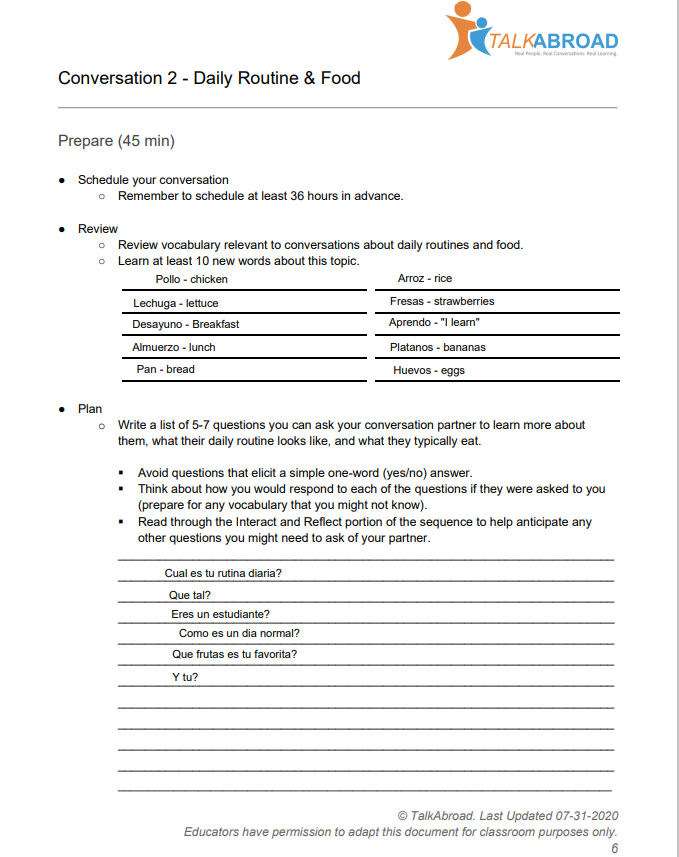Interpretive, Interpersonal, and Presentational Modes of Communication
Exploring Culture
In our class we learned much of the Latin American and Hispanic cultures through the VHL videos we would watch during our homework assignments. Through these we could catch a glimpse of what life is like in other parts of the world, and broaden our worldview. Whether it be what life is like in Peru, or what kinds of food are available in Spain, these videos exposed us to new ideas and ways of doing things we may not have otherwise seen. For example, looking at the grocery store ads from Spain showed me that the people over there tend to use more glass bottles and recycle while we here in the US rely more on single-use plastic.
Engaging in Communities
Engaging in our immediate community and the global community is always something to value. Whether it be learning who your neighbors are, or simply offering help when you see someone in need. This same way of thinking can be placed on learning the Spanish language, and how reaching out to something new can give you a new perspective on the way you view your own place in your community.
Interpersonal Communication

Twice during the semester we took part of a program known as Talkabroad. In this program, we were exposed to native Spanish speakers and were tasked with carrying a timed conversation with them.
While the Talkabroad conversations were certainly something new and something to be nervous about, they were also exciting. For example, both of my talkabroad partners were interested in comic books and the nerd culture, which I learned by using the vocabulary I had and asking them as best I could. And while I struggled with the first conversation, by the time I reached my second speaking partner, I felt much more confident in my abilities as a Spanish student.
Presentational Speaking
Twice during the semester we used a program called Flipgrid in order to present our knowledge of the Spanish language to our class. Our first Flipgrid was to introduce ourselves to the class, while our second one was to describe our daily routine.
For our first Flipgrid activity, introducing myself and describing myself was not that challenging. The hardest part was shaking off the cobwebs of not having a Spanish lesson in nearly a year by that point. But as we continued to learn and grow in our abilities over the semester I felt much more confident in what I was able to do in this class. Until by the end when I could more easily describe how my day goes using things like preterite forms of verbs.
Presentational Writing
In class we had two compositions we wrote over the course of the semester. one to describe our daily routine while the other was to describe a restaurant that we enjoy eating at. Here is my second composition:
“Un restaurante en Norfolk es Del Vechio’s cerca de ODU en Hampton bulevar. Del Vechio’s es una tienda de pizza. Me gusta Del Vechio’s porque el especial de almuerzo es el mejor. También, los empleados cocinan rápido. La tienda es pequeña, pero tiene baño, muchas mesas, y a veces tiene el videojuego Pac-Man. Voy a Del Vechio’s una o dos veces por semana. Fui ayer después de la clasé.
Del Vechio’s tiene muchas cosas en el menu. Hay muchas bebidas, por ejemplo refrescos, agua, té, y cervezas. También, tiene pizza con algunos ingredíents, ensalada Greek (con lechuga y queso feta y vinagre), y sandwiches con carne y queso. Después de las tres en la tarde, una pieza de pizza cuesta un dólar. También, el especial de almuerzo es dos piezes de pizza algunos ingredients y un refresco por seis dólares. Me encanta el especial de almuerzo con pizza con queso y pizza con carne, es barata y sabrosa.
Me gusta Del Vechio’s porque tiene buen ambiente. También los camareros son amables y muy agrables. Cuando te quieres pizza en Norfolk, yo recomiendo Del Vechio’s.”
Again, my growth as a Spanish writer certainly improved as the semester. While I struggled at first to correctly remember which verbs to use. With this composition, I was much more confident, and I had a larger vocabulary to choose from to say what I wanted to say more accurately.
Interpretive Listening
In our class, multiple times we would listen to lessons given in Spanish and have to interpret just what it was that we were hearing.
Some of these things included the Flash Cultura activities on VHL, or learning about the markets in Spain. At first, I would need to listen to some of these multiple times before I would finally understand what was being said, but over time I would find myself listening to them less and less before I could understand what was being said.
Interpretive Reading
One of the biggest thing we did in Spanish 102 was Interpretive Reading. Whether it be reading from the textbook, or reading stories to try and figure out how to extract information, we did a lot of reading in this class.
While I feel I had a good grasp of how to read the Spanish language going in to this class, my ability to understand and interpret just what I was reading needed some work, and work on it I did. Over the course of this semester, I learned new ways to view the language. To recognize endings of words, and understand how they are being used whether that be past tense, present, or the preterite. By the end of this course, I definitely feel like my abilities as a Spanish reader have evolved, and I look forward to how I might use these abilities in the future.